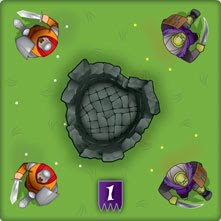
The castle is under siege! Wave upon wave of goblins, orcs, and trolls want to destroy the walls and collapse the towers! Can someone slay enough monsters to save the castle and become the Master Slayer? Or will all be lost? This is the scenario of
Castle Panic, an elegantly simple game that is both cooperative and competitive.
The board of
Castle Panic is divided into six sections, numbered 1-6 and colored red, green, or blue, that go from sections (Forest, Archer, Knight, Swordsman) into the castle wall, behind which is a tower. These sections determine both where players can do damage and where monsters appear and advance.
Players draw cards, can discard and redraw, and trade one or two cards with other players(depending on the number of players) -- then it's time to attack! Most cards let a player do a point of damage to a monster in a certain section in a certain color. There are also specialty cards like Tar (stops a monster from moving), Barbarian (killing a monster in the castle), Nice Shot! (killing a monster with one hit), Hero (which can deal one damage to any figure in a certain color), and Missing (preventing monster tokens from being drawn at the end of the turn). The cards Brick and Mortar can be played together to rebuild one destroyed wall.

Ah, the monsters tokens. Goblins take one hit, Orcs take two, and Trolls can take three. (The pieces are triangular, and the part pointing at the castle shows their remaining life.) There are four bosses, each of whom have a special ability. Then there are Plagues (making all players discard one type of card), tokens requiring 3 or 4 tokens to be played, and the Giant Boolder, which crushes all monsters in its path -- and only stops when it hits and destroys a wall or castle.
After players attack, all monsters on the board move closer to the castle. When a monster moves from the Swordsman ring against a wall, the monster takes one damage and the wall is destroyed. If a monster enters the castle, they move clockwise, taking one damage when moving against and destroying a tower. And if the last tower falls, everyone loses. At the end of each turn, players draw two random monster tokens, putting monsters in the Forest (rolling the die to see where they go) and applying the effects of other tokens.
If the last tower falls, all players lose. But if they players defeat all the monsters, the players get points for each monster they slew (Goblins are worth one point, Orcs are worth two, Trolls are worth three, and bosses are worth four) and whoever has the most points wins, becoming the Master Slayer!
 Castle Panic
Castle Panic is simple, yet is plays almost perfectly. The rules are very easy to learn, the setup is simple, and play can start in a few minutes. The relentless attacks of monsters creates a real feeling of dread and oppression, and most players will be likely to help one another (by giving advice and trading cards) rather than refuse help and look out for themselves. The stand-up walls and towers are a nice visual element, and having the life on the monsters represented on the part pointing to the castle obviates the need for pen and paper. There's even a solo mode for solitaire play! While there's not a lot of strategy here -- kill the monsters before they breach the walls --
Castle Panic is great fun to play -- and replay!
Overall grade: A-
Reviewed by James Lynch

 Sports Illustrated: Exposure is different from most Sports Illustrated swimsuit shoots. Instead of having numerous locations, a wide variety of swimsuit colors and styles, and (more recently) body paint, this collection of photos was taken over a 10-day period in Harbour Island in the Bahamas. Photographer Raphael Mazzucco also had the models clad in a variety of all-white swimwear.
Sports Illustrated: Exposure is different from most Sports Illustrated swimsuit shoots. Instead of having numerous locations, a wide variety of swimsuit colors and styles, and (more recently) body paint, this collection of photos was taken over a 10-day period in Harbour Island in the Bahamas. Photographer Raphael Mazzucco also had the models clad in a variety of all-white swimwear.
 Sports Illustrated: Exposure is a true wonder. It would be hard to imagine a more perfect collection of models to be photographed together (though if you can, we do have a comments section), and the photos are both stylish and natural. One may feel having nothing but all-white swimwear is limiting, but there's no repetitive feeling in the photographs here. Sports Illustrated: Exposure is, simply, amazing.
Sports Illustrated: Exposure is a true wonder. It would be hard to imagine a more perfect collection of models to be photographed together (though if you can, we do have a comments section), and the photos are both stylish and natural. One may feel having nothing but all-white swimwear is limiting, but there's no repetitive feeling in the photographs here. Sports Illustrated: Exposure is, simply, amazing.
































